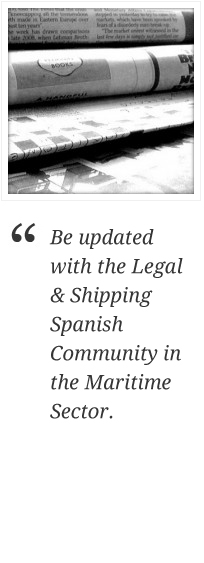CIRCULAR 2B/2020 CONTAINER DAMAGES CAUSED BY STEEL COILS
APRIL 2020
CONTAINER DAMAGES CAUSED BY STEEL COILS WHEN SHIPPED SEPARATELY
A repeated situation regarding steel coil cargoes, leading to the collapse of containers floors due to bad stowage and / or lashing, has been noticed and studied by a survey company with whom we collaborate.
We would like to briefly summarize this problem, as well as provide some measures that can be used to prevent this from happening, based on the information provided by SEDGWICK IBERIA.
The failure of the floor of TEU’s containers can be explained by the combined effect of these four factors:
- The size of the steel coils when shipped separately (4 to 26 tons).
- The stowage and lashing conditions
- The maximum load of a container vs the specific maximum load permitted on the container floor
- The temporary increase in weight caused by the acceleration forces acting on navigation conditions
The first factor is that single coils are frequently centered on the containers’ bottom, which combined with excess to the specific load that can be beared by the container floor, prevents the right distribution of the cargo weight all over the container loading floor.
The second factor is placing the steel coil in the “eye to side†or “eye to rear†position. When the coil is placed this way over the container flooring, if a stowage structure is not used, or if it isn`t strong enough according to its structural type or if the coils aren`t duly lashed, there is a shifting that collapses the structure. When this happens, the securing system is unable to perform its task and the coil rests directly over the container floor.
The third factor is that even though the maximum load of a container is not surpassed by the coil, the specific maximum load permitted on the container floor is being far exceeded due to the stress exerted by the coil when placed in the middle of the container.
Apparently, the above mentioned containers are not designed to withstand that specific weight and even when the maximum load is not exceeded, the proper distribution of the weight of the cargo is disregarded.
Finally, the temporary increase in weight caused by the acceleration forces acting during navigation conditions requires a sufficiently strong container able to manage the downward vertical acceleration undergone by the coil to prevent the stowage structure from collapsing.
MEASURES TO AVOID THESE KIND OF DAMAGES
According to the technical criteria of surveyors, these measures should be followed to avoid these kind of damages:
- “Build stowage structures in such a way that they are enhanced by longitudinal bottom side rails as the I-beams of the container flooring are close enough so as no cross members’ reinforcement is needed, regardless of the direction in which the coils are loaded on.
- The proper ways to stow on the container this type of cargo are specified in the ‘IMO/ILO/UNECE Code of Practice for Packing of Cargo Transport Units†(CTU Code), 2014. More precisely, in chapter 9, section 9.3, where it is stated: ‘Packers should ensure that: The load is properly distributed in the CTUâ€.
- The same Code, in annex 7, section 3.1, specifies the following: ‘When the payload is not homogeneously distributed over the loading floor, the limitations for concentrated loads should be considered. It may be necessary to transfer the weight to the corner posts by supporting the cargo on strong timber or steel beams as appropriate.
- It should be taken into account the temporary increase in weight caused by the acceleration forces acting on navigation conditions.
- Securing of heavy cargo transport is simply essential for the proper arrival at destination of any kind of loaded goods and so avoiding damages to the coil itself, to the container or to other nearby goods.â€
Further technical information and measures can be read in the article Collapse of containers floors due to bad stowage and – or lashing of steel coils where these measures are quoted from.
This problem arises more frequently when the ordered coils come from North Africa where the necessary conditions for the adequate transport of separate steel coils have not been studied in depth.
We have the legal expertise to assist if this kind of problems arises as well as the experience needed to provide you with the technical guidance – through our collaborating surveyors – required to prevent these damages.

